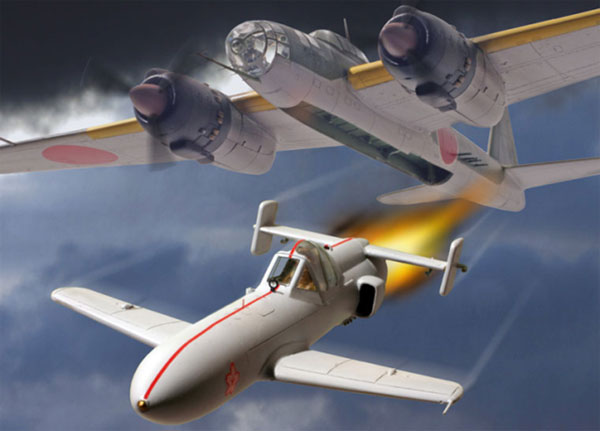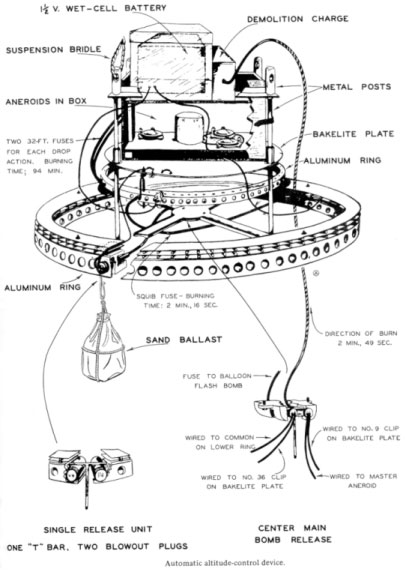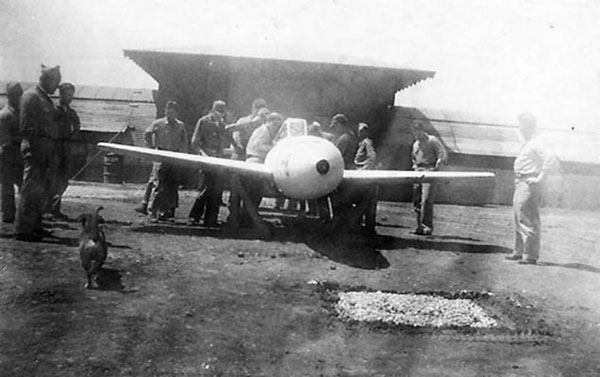11 secret weapons developed by Japan during World War II
We have heard a lot about the scientific and technological achievements, a variety of technologies and weapons manufactured by Western countries during the Second World War. Meanwhile, there is a fact that Japan - A Axis War Party, also experimented with many new technologies in this war. Here are 11 secret weapons that the country has built and put into trial at that time.

The Japanese Empire began to rise to a great power in 1905 after defeating the Russian Empire in the "first great war of the 20th century" to gain control of Manchuria and Korea. Although in the First World War, Japan belonged to the Treaty, but by the Second World War, the loyalty of the Japanese Empire had shifted when the Versailles treaty was written down by Hitler. Since the 1930s, the Japanese Empire began a series of campaigns to proactively affirm its strength in the Pacific. This action eventually led them to conflict with the United States.
In the period of Chieu Hoa (Shōwa), the Japanese Empire continued to gain many outstanding achievements in both industrial strength and science and technology to catch up with other countries. Finally, the Japanese Empire had a military system with advanced weapons, especially a variety of suicide weapons and even weapons to carry out biological and chemical warfare. And of course, all these weapons did not comply with the Geneva Convention and even, they argued that the more banned the weapon was, the more effective the war was. Since then, dozens and hundreds of "heavenly" weapons have been built and brought to the test on the battlefield.
1. Bomb balloon Fu-Go
If Nazi Germany has a V2-oriented missile system, Japan also has a similar "retaliatory weapon" system. However, instead of developing intercontinental missiles, Japanese military proposed the idea of a balloon carrying a balloon.


The balloon will carry fire bombs below, crossing the distance of 5000 miles (more than 8000km) to the United States by relying on the beam (Jet-Stream, the strong wind from the West blowing high above). This is a cheap weapon, built with the purpose of detonating in the Pacific Northwest jungle areas, creating large forest fires and dispersing human resources of the United States.
The first balloons were released at the end of 1944, landing in the US on November 5 at the outskirts of San Pedro, California. The next aircraft flew farther, to Thermopolis, Wyoming and some even landed in Canada. According to the records, 285 air balloons completed their mission. On March 5, 1945, six Americans were killed by one of these balloons in Oregon while they were trying to drag it to their farms. The US government now prevented the media from reporting these balloons as a psychological intention. And it wasn't until after the war that the American public learned about these balloons.
2. Submarine class Sen Toku class

The drawing of the submarine class Sen Toku
There were 3 giant Sen Toku I-400 class submarines built by Japan during the war. This "submarine monster" is considered the most modern submarine in the world in WW2. This is part of Japan's Pacific dominance plan and includes the west coast of the United States. At the same time, it was also used to plan operations in Panama. The ship was equipped with 3 Aichi M6A1 aircraft carrying an amount of bombs up to 800 kg and could take off right from the submarine. The hull is reinforced for absolute waterproofing and withstands pressure. The planes can take off at the front launcher and all three can be assembled, fueled, armed and launched within 45 minutes.

Image of super submarine Sen Toku class when emerging
At the same time, the I-400 is equipped with a similar ventilation tube as the German ship, but is covered with thick material, similar to rubber to absorb radar and ultrasound signals. However, the war ended before the Japanese army could bring it into action. In 1946, I-400 surrendered to the US military and was sunk off the coast of Hawaii and until 2013, researchers had to salvage it for research.
3. Unit 731 and Biological weapons

Unit 731 - the Japanese Empire's secret biochemical weapons development unit
From 1937 to the end of the war, Japan experimented with a variety of biological weapons, including bombs containing defoliants (one of the predecessors of Agent Orange) and bombs used to spread disease spread. Unit 731 is a secret unit of research and development of biochemical weapons. It has done experiments on the human body with agents of plague, cholera, smallpox and many other infectious diseases. The Japanese military uses bombs that carry this pathogen to initiate biological attacks. Its main goal is to adopt food and water to cause disease in residential and military areas.

A victim in bio-weapons testing
According to Sheldon H. Harris, a historian at the University of California, more than 200,000 Chinese people were killed in these biochemical weapons tests. This number is still a controversial issue since most of the documents and records were destroyed during the war. One historian also said that Japan used to use Shen Feng fleet to drop bombs containing fleas that carried germs into the US in the summer of 1945.
4. Fukuryi diving suits

Drawings of suicide diving suits
This special diving suit is designed to help Japan resist Allied attacks. The suit is equipped with a mine that contains 15 kg of explosives and attaches to the head of a 5 meter long bamboo tube. The wearer will be submerged into the water with a 9 kg lead, then walk under water for about 6 hours at a depth of 5 to 7 meters. After reaching the enemy's body, the wearer will detonate and die with the enemy ship. The report said some US amphibious ships and patrol boats were attacked by suicide bombers. However, it is unclear whether they use the diving suit or not.
5. "Purple" encoder

Photograph of a Purple coding machine stored to this day
The German army's Enigma machine may be the most famous encryption tool in World War II, but it is not the only machine. In 1937, the Japanese army developed the "97-shiki O-bun In-ji-ki" machine or "97 Alphabetical Typewriter". Americans nicknamed it "Purple" (purple machine). The machine consists of 2 keyboards and 1 rotary disc system with 25-connected circuit board (25 pairs of characters). Similar to Enigma machines, the first keyboard is used to import unencrypted text in English, Romaji, Roman characters or mixed together.
However, if the Enigma machine displays text in the blinking form of the lights, the Purple machine uses a second keypad. This keyboard will type the encoded text into a piece of paper. The coding work done by 4 rotating discs and the circuit board containing 25 connections will randomly sort into 6 pairs of connections and create 70,000,000,000 different arrangements. Not only can it encode in many ways but it also comes with a secret string of characters to decode. This sequence will be changed daily so even if the enemy steals Purple, it cannot be decoded without this string.
6. Yokosuka aircraft MXY-7 Ohka

Yokosuka MXY-7 Ohka suicide missile image
Yokosuka MXY-7 Ohka is essentially a manned anti-ship anti-ship missile belonging to the Than Phong detachment of the Japanese army. Ohka was officially put into operation in September 1944 and was built on the principle of using as few materials as possible because it mainly served suicide. During the operation, Ohka is attached to the bottom of the mother plane, the Mitsubishi G4M. When approaching the target, it will be activated and the pilot tries to reach as close to the target as possible before the rocket starts and explodes when it hits the target.

A detailed drawing of Yokosuka MXY-7 Ohka suicide missile
Ohka is equipped with a warhead weighing approximately 1200 kg. With an intense speed when traveling, Ohka can't seem to be intercepted by air defense systems. However, its biggest drawback is very vulnerable when the mother plane flies in the sky. Moreover, rockets are also difficult to control the exact flight direction. Despite many shortcomings, at least one US military destroyer was sunk by this type of missile.
7. Mitsubishi J8M aircraft

Image of the JM8 rocket engine interceptor, an improved version of the Messerschmitt Me 163 Komet developed by the Nazis
Mitsubishi J8M is a rocket engine interceptor fighter belonging to the Japanese Imperial Army during World War II. J8M is considered a licensed copy of the Messerschmitt Me 163 Komet developed by the Nazis. However, the Germans were unable to send the official version to Japan, as submarines carrying planes were sunk on transit. However, Japanese engineers created a more modern fighter aircraft than the German version.

Detailed drawings of J8M aircraft
This is a model developed to serve the bombing campaign on Allied forces in Europe. The Japanese think that this needs to be done as soon as possible, before the Allies do the same in Japan. However, no completed J8M model has been put into use, but only one prototype was built shortly before the war ended.
On July 7, 1945, the first flight was carried out by the commander of Navy Toyohiko Inuzuka. Initially, it successfully took off, but the engine failed while raising altitude, then exploded causing the pilot to die. The next six prototypes were also built, but none of them could fly and the war ended, ending the short series of this ambitious model.
8. OI super heavy tanks

Figure drawing of super tank OI
Japan is not a famous country for tanks, but at the end of the war, they come up with bold and even crazy ambitions, making a super heavy tank to use on the face. Pacific battle. As its name suggests, the whole car is expected to weigh between 100 and 120 tons. It possesses 3 turrets, 1 huge cannon and 2 smaller size sub-guns. An unconfirmed information indicates that this car was built and even moved to Manchuria, yet never seen it appear on the battlefield.

In a drawing, the designers also wanted to equip it to four turrets
9. Ku-Go destroying rays
Similar to many other weapons models, Japan has also attempted to develop a kind of destructive ray in the hope of using it to destroy planes that are many kilometers high in the sky. According to documents confiscated by the US military after the war, the study of this type of beam began in 1939 at the Noborito laboratory. Eventually, the researchers developed an extremely powerful magnetron capable of producing radiation.
Physicist Sinitiro Tomonaga in the group created a magnetron lamp with a diameter of 20 cm with a capacity of 100 kW. However, this is still a fictional experiment. According to estimates, this type of light is only enough to kill a rabbit 1000 meters away, provided that it has to stand still for 5 minutes to shine.
10. Tank flying

Photo sketching a tank flying by the Japanese Empire
One of the challenges of the Japanese army in WW2 is to move heavy mechanical equipment such as tanks from one island to another. And of course, a proposed solution is to turn the tank into a flying weapon instead of just running on the ground.
According to the idea, these will be lightweight tank cars with wings, flight stabilizers and take-off wheels that can be removed. However, there was no runway that could stand the landing of this car, so it was added with skis below to land. Once the components were removed, it returned to the shape of an airplane to fight underground land. While flying, it can still be used as a roller coaster bombing ground targets. Under the plan, the Japanese military is preparing to build several flying tanks, including the Kueda 6 Maeda and Special No. 3 Flying Tank, or Ku-Ro.
11. Z bomber project

Prototype of Nakajima G10N bomber in project Z
Similar to the Nazika's bomber project, Japan also wants a plane that can bomb across the continent, into targets in North America. In 1941, the Imperial Japanese Navy tested 13-Shi attacks, four-engine long-range bombers. But military planners want something bigger, heavier and faster. Hopefully, it will be something that can carry more than 22 450 kg bombs and fly to an altitude of approximately 10 km.
The designs submitted include the Nakajima G10N (pictured above) and Kawasaki Ki-91, featuring a 72-meter wingspan and a total length of 43 meters. It can reach 590 km.h at 7.62 km high with 5 engines, each engine has a capacity of 5000 horsepower. After that, Nakajima aircraft company started developing engines for aircraft and promised to double its capacity compared to the HA-44 engine (the most powerful engine in Japan at that time). However, in the end, Project Z was canceled due to the worsening war situation in 1944.
These are the 11 secret weapons that the Imperial Japanese army developed during the Second World War, a catastrophic war in human history. Too many people have died, physical damage cannot be counted and some cannot be overcome until today. Hopefully the article has provided some interesting information for you and hope the world will be peaceful.
Reference: JPF, NYT, Rogers, iO9 (1), (2), Warpadons.
- Secret secret weapon used to assassinate during World War 2
- Russia developed a more secret weapon than a nuclear bomb
- Secret weapons of insects
- The United States created a weapon that produced a voice that terrified the enemy
- The most feared nuclear weapons systems in the world
- Small weapons like insects can destroy humanity
- America's top secret biochemical weapons testing facility
- Mysterious aircraft rumors America deployed space weapons
- The 5 most feared weapons in World War I
- Impressive figures on American super weapons
- Ancient weapons of destruction
- To destroy the world, only 10 fusion bombs are needed
 'Fine laughs' - Scary and painful torture in ancient times
'Fine laughs' - Scary and painful torture in ancient times The sequence of numbers 142857 of the Egyptian pyramids is known as the strangest number in the world - Why?
The sequence of numbers 142857 of the Egyptian pyramids is known as the strangest number in the world - Why? History of the iron
History of the iron What is alum?
What is alum?